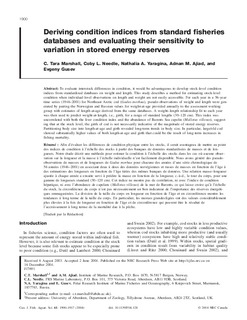Deriving condition indices from standard fisheries databases and evaluating their sensitivity to variation in stored energy reserves
Journal article, Peer reviewed
Permanent lenke
http://hdl.handle.net/11250/108492Utgivelsesdato
2004Metadata
Vis full innførselSamlinger
- Articles [3011]
Originalversjon
http://dx.doi.org/10.1139/F04-128Sammendrag
To evaluate interstock differences in condition, it would be advantageous to develop stock-level condition indices from standardized databases on weight and length. This study describes a method for estimating stock-level condition when individual-level observations on length and weight are not easily accessible. For each year in a 56-year time series (1946-2001) for Northeast Arctic cod (Gadus morhua), pseudo-observations of weight and length were generated by pairing the Norwegian and Russian values for weight-at-age provided annually to the assessment working group with estimates of length-at-age derived from the same databases. A weight-length relationship fit to each year was then used to predict weight-at-length, i.e., girth, for a range of standard lengths (30-120 cm). This index was uncorrelated with both the liver condition index and the abundance of Barents Sea capelin (Mallotus villosus), suggesting that at the stock level, the girth of cod is not necessarily indicative of the magnitude of stored energy reserves. Partitioning body size into length-at-age and girth revealed long-term trends in body size. In particular, large/old cod showed substantially higher values of both length-at-age and girth that could be the result of long-term increases in fishing mortality.
